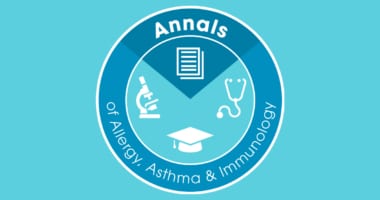 I am guessing that by now most of you are staying inside as much as possible this long, hot summer, which has really just begun in many parts of the country. I can think of only a few things more useful to you professionally than spending some time reading this month’s issue of the Annals of Allergy, Asthma and Immunology. This issue has many different features that will assist you in your day to day clinical practice. Let me point out a couple of them for you.
I am guessing that by now most of you are staying inside as much as possible this long, hot summer, which has really just begun in many parts of the country. I can think of only a few things more useful to you professionally than spending some time reading this month’s issue of the Annals of Allergy, Asthma and Immunology. This issue has many different features that will assist you in your day to day clinical practice. Let me point out a couple of them for you.
The first is by Anita Sivam, DO and Mike Tankersley, MD, MBA, FACAAI from Memphis who report updated information on current practices and perceptions about sublingual immunotherapy (SLIT) among American allergists. Their work, on behalf of the College’s Immunotherapy and Diagnostics Committee, showed significant increase in SLIT prescriptions among American allergists over the past five years even with the most commonly described limitation of only having monotherapy available with each tablet preparation.
More from Annals that you won’t want to miss:
- Non-Ige-mediated food allergic gastrointestinal disorders: feeding difficulties in children and food sensitivities involving the gut
- The importance of shared decision-making and the correlation between asthma control and school performance
- Clinical issues in the allergist-immunologist’s office due to racial differences
Another review article authored by Michael Levin, MD, PhD, FACAAI and colleagues from South Africa provides an overview of the galactose a-1,3-galactose (a-gal) sensitization story from the perspective of different populations’ susceptibility and presentation. They point out that there are now multiple tick species implicated in the phenomenon and differences in sensitivity among various populations may represent differences in exposure to tick bites. They also point out that the pathophysiology of the delayed reaction is still poorly understood but may be related to differences in digestion and metabolism of offending foods among various patient populations.
The editors and staff of the Annals appreciate your support of our journal by reading – and especially commenting – on things you find useful, that you disagree with or that you might have questions about. We would like to publish your comments and questions in our correspondence section. I invite your comments. Please send them directly to me.
Gailen D. Marshall, Jr., MD, PhD, FACAAI
Editor-in-chief

